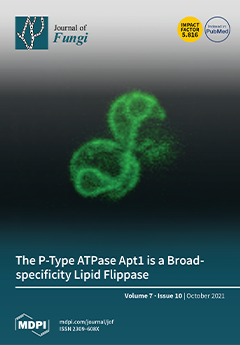The genus
Calonectria includes pathogens of various agricultural, horticultural, and forestry crops. Species of
Calonectria are commonly collected from soils, fruits, leaves, stems, and roots. Some species of
Calonectria isolated from soils are considered as important plant pathogens. Understanding the species diversity and
[...] Read more.
The genus
Calonectria includes pathogens of various agricultural, horticultural, and forestry crops. Species of
Calonectria are commonly collected from soils, fruits, leaves, stems, and roots. Some species of
Calonectria isolated from soils are considered as important plant pathogens. Understanding the species diversity and distribution characteristics of
Calonectria species in different soil layers will help us to clarify their long-term potential harm to plants and their patterns of dissemination. To our knowledge, no systematic research has been conducted concerning the species diversity and distribution characteristics of
Calonectria in different soil layers. In this study, 1000 soil samples were collected from five soil layers (0–20, 20–40, 40–60, 60–80, and 80–100 cm) at 100 sampling points in one 15-year-old
Eucalyptus urophylla hybrid plantation in southern China. A total of 1037 isolates of
Calonectria present in all five soil layers were obtained from 93 of 100 sampling points. The 1037 isolates were identified based on DNA sequence comparisons of the translation elongation factor 1-alpha (
tef1), β-tubulin (
tub2), calmodulin (
cmdA), and histone H3 (
his3) gene regions, as well as the combination of morphological characteristics. These isolates were identified as
C. hongkongensis (665 isolates; 64.1%),
C. aconidialis (250 isolates; 24.1%),
C. kyotensis (58 isolates; 5.6%),
C. ilicicola (47 isolates; 4.5%),
C. chinensis (2 isolates; 0.2%), and
C. orientalis (15 isolates; 1.5%). With the exception of
C. orientalis, which resides in the
C. brassicae species complex, the other five species belonged to the
C. kyotensis species complex. The results showed that the number of sampling points that yielded
Calonectria and the number (and percentage) of
Calonectria isolates obtained decreased with increasing depth of the soil. More than 84% of the isolates were obtained from the 0–20 and 20–40 cm soil layers. The deeper soil layers had comparatively lower numbers but still harbored a considerable number of
Calonectria. The diversity of five species in the
C. kyotensis species complex decreased with increasing soil depth. The genotypes of isolates in each
Calonectria species were determined by
tef1 and
tub2 gene sequences. For each species in the
C. kyotensis species complex, in most cases, the number of genotypes decreased with increasing soil depth. The 0–20 cm soil layer contained all of the genotypes of each species. To our knowledge, this study presents the first report of
C. orientalis isolated in China. This species was isolated from the 40–60 and 60–80 cm soil layers at only one sampling point, and only one genotype was present. This study has enhanced our understanding of the species diversity and distribution characteristics of
Calonectria in different soil layers.
Full article






